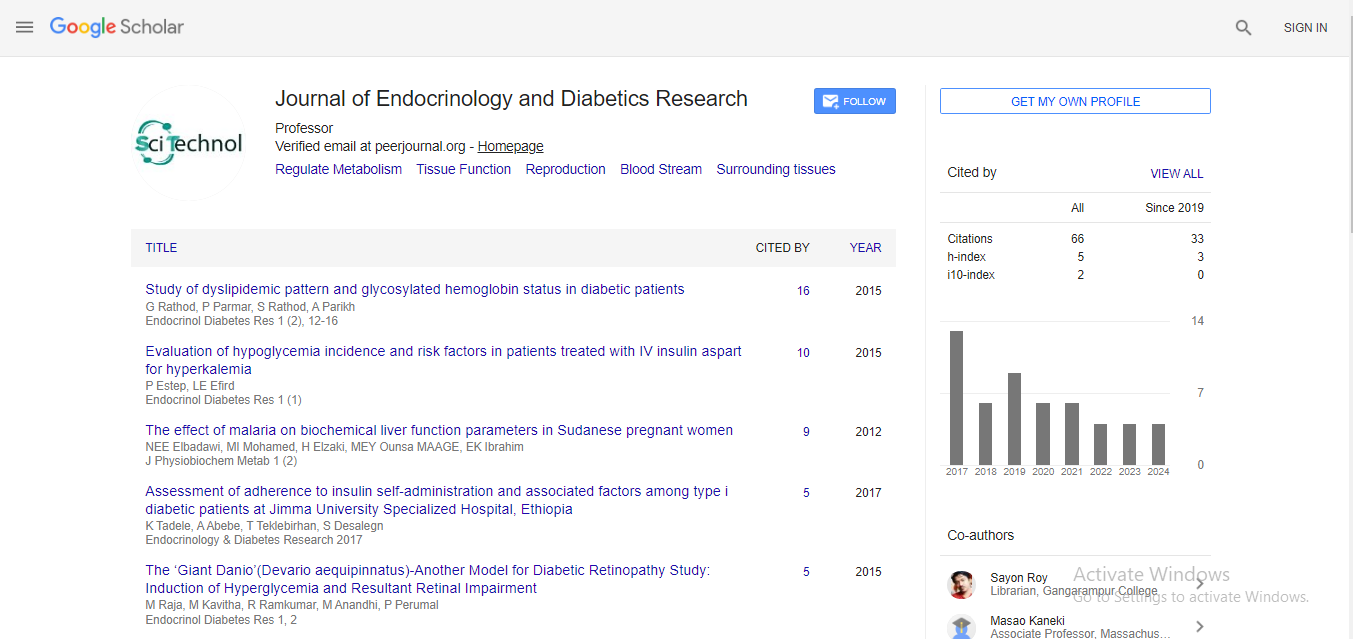Perspective, Endocrinol Diabetes Res Vol: 10 Issue: 5
The Relationship between Obesity and Endocrine Disruptors in Metabolic Disease
Tobias Bauer*
1Department of Metabolic Medicine, University of Heidelberg, Heidelberg, Germany
*Corresponding Author: Tobias Bauer,
Department of Metabolic Medicine,
University of Heidelberg, Heidelberg, Germany
E-mail: bauer_meta@edu.org
Received date: 23 September, 2024, Manuscript No. ECDR-24-149300;
Editor assigned date: 25 September, 2024, PreQC No. ECDR-24-149300 (PQ);
Reviewed date: 09 October, 2024, QC No. ECDR-24-149300;
Revised date: 17 October, 2024, Manuscript No. ECDR-24-149300 (R);
Published date: 25 October, 2024, DOI: 10.4172/2324-8777.1000421
Citation: Bauer T (2024) The Relationship between Obesity and Endocrine Disruptors in Metabolic Disease. Endocrinol Diabetes Res 10:5.
Abstract
Description
Obesity has become a significant global health concern, influencing the prevalence of metabolic diseases such as type 2 diabetes and cardiovascular disorders. While traditional factors like diet and physical activity are well recognized, emerging research highlights the role of endocrine disruptors as critical components in the development of obesity and its associated metabolic diseases. Endocrine disruptors are chemicals that can interfere with the body's hormonal system. They are found in numerous everyday products, from plastics to personal care items and can have wise effects on metabolic health. Understanding how these substances contribute to obesity is essential for developing effective interventions.
The relationship between obesity and endocrine disruptors is complex. These chemicals can mimic or block hormones, leading to alterations in metabolic processes. For instance, substances like Bisphenol A (BPA) and phthalates have been shown to influence fat cell differentiation and insulin sensitivity. Research indicates that exposure to these disruptors during critical developmental periods can predispose individuals to obesity later in life. Studies have demonstrated that endocrine disruptors may act synergistically with genetic predispositions to obesity. For example, individuals with certain genetic variants may be more susceptible to the effects of these chemicals, amplifying the risk of weight gain and metabolic dysfunction. This relationship suggests a multi-faceted approach is necessary when addressing obesity, taking into account both environmental exposures and genetic factors.
Furthermore, the timing of exposure is vital. Prenatal and early childhood exposures to endocrine disruptors can have lasting effects on metabolism. Animal studies indicate that exposure to these chemicals during gestation can lead to increased fat accumulation and metabolic disturbances in offspring. Such findings bring out the importance of preventive measures targeting vulnerable populations, particularly pregnant women and young children. Dietary patterns also play a significant role in modulating the effects of endocrine disruptors. A diet high in processed foods may increase the impact of these chemicals, as many processed items contain additives that can act as endocrine disruptors themselves. Conversely, a diet rich in whole foods, particularly fruits and vegetables, may offer some protective effects against the harmful impacts of these substances. This suggests that promoting healthy eating habits can be a vital strategy in decreasing the risks associated with endocrine disruptors.
Public health initiatives are increasingly focusing on reducing exposure to endocrine disruptors. Regulations limiting the use of certain chemicals in consumer products aim to decrease overall exposure. Additionally, raising awareness about the sources of these disruptors can empower individuals to make informed choices. Simple actions such as using glass or stainless steel containers for food storage instead of plastic can significantly reduce exposure to harmful substances. Research into the mechanisms by which endocrine disruptors influence metabolic disease is ongoing. Understanding how these chemicals alter hormonal signaling and metabolic pathways will provide valuable insights into potential therapeutic targets. For instance, identifying specific pathways disrupted by these chemicals could lead to the development of new treatments aimed at restoring normal metabolic function.
The relationship between obesity and endocrine disruptors is a pressing issue that demands attention from researchers, healthcare providers and policymakers alike. As the prevalence of obesity continues to rise, so too does the need for comprehensive strategies to combat this epidemic. Addressing the role of environmental factors, particularly endocrine disruptors, is essential in this fight. In conclusion, the relation between obesity and endocrine disruptors is a complex yet vital area of study in understanding metabolic disease. By recognizing the influence of these chemicals on metabolic health, we can better address the obesity epidemic. Continued research, public health initiatives and individual awareness will be instrumental in reducing exposure to endocrine disruptors and promoting healthier lifestyles. Ultimately, tackling this issue not only has implications for individual health but also for public health on a larger scale.
 Spanish
Spanish  Chinese
Chinese  Russian
Russian  German
German  French
French  Japanese
Japanese  Portuguese
Portuguese  Hindi
Hindi 


